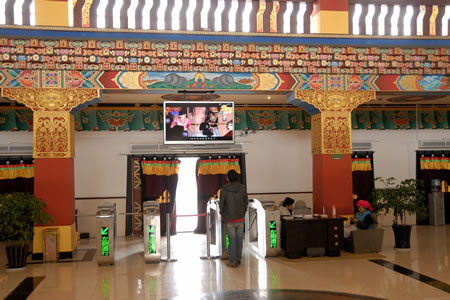

| The price tag of development | |
Xiāngchéng (China), May 17th 2010 |
|
We are at least 10 years too late in some places of China. The Chinese are busy to spoil lots of the gems of their country with overdevelopment. Last winter, we already noticed that some picturesque villages can only be visited after paying a ridicules entrance fee and a finger scan. But this isn’t the only case of overdevelopment. Yesterday, we were in Shangri-La to visit its most important monastery. The monastery lies several kilometres outside the city, so we decided to walk. While walking you always see some nice things like markets and strange kinds of shops, but this wasn’t the purpose of this day. The Ganden Sumtseling Gompa is the most important sight of the city, and we were looking forward to see it. In China we are carrying two travel books. The edition of 2007 mentions an entrance fee of 10 Yuan (+/- 1 euro) and the edition of 2009 writes about a fee of 30 Yuan (3 euro). So, we are mentally prepared to pay an admission fee and we even think it is very reasonable. Lots of travellers easily forget to pay a donation after visiting a monastery, so collecting an entry fee seems very logical. |
|
 |
|
High-tech admission control at the Ganden Sumtseling Monastery in Shangri-La |
|
When we were a kilometre outside the city, we bumped into a “Scenic Area” that doesn’t appear on our map. The Scenic Area consists of several hotels under construction and some souvenir stalls that aren’t finished yet. The only part of the area that is up and running is the gigantic newly built ticket office. This office is built 7 kilometres in front of the monastery, to be sure that a hill blocks the view for everybody who doesn’t pay the admission fee. A non-paying guest cannot even get a glimpse of the religious complex. To see it, you have to buy the ticket and pass the modern metro gates to step into a bus that will bring you to the monastery. We are certainly lucky having budgeted 3 euro per person for visiting this sight! (For European standards this is still a bargain, but it is a lot of money in a country where more than 200 million Chinese are still living of less than 1 US$ per day.) Flabbergasted, we hear that the entrance fee is increased since January 2010 to 85 Yuan. An inflation of 283% seems enormous, but the ticket seller says that it is completely explainable. The ticket office is newly built and equipped with modern metro gates, visitors can get to the monastery by bus and there is a Chinese speaking guide available. Previously, the public transport only cost 1 Yuan (0,10 euro), hence, it is gotten a lot more expensive for an English speaking visitor while getting nothing in return. When we indicated that we prefer to walk, the Chinese are very compliant. We are able to walk the seven kilometres, but only after paying the entrance fee in full. The ticket seller, not only sells tickets but he is also passionate to sell the price increase. He continues by saying that this is the price tag on development. In 2009, Shangri-La and its monastery weren’t developed like it is developed now. He couldn’t really answer our question about what the impact of “development” is on the main reasons to come here: the monastery and the religion. However, he could tell us that half of the money will go to the monastery and the other half goes to the state. Tourism has turned into big business for both parties, but we have skipped this sight off our itinerary. A fully commercialized monastery is more like a museum and doesn’t have the atmosphere and the ambiance that we want to associate with Tibetan Buddhism. In India, we already experienced a lot of this and luckily also in China there are enough places left where we aren’t to late. Today we are in Xiāngchéng, where we only had to share the monastery with the monks (see also the photo impression of Xiāngchéng). This monastery was completely destroyed during the Cultural Revolution; an invention of the predecessors of the current government. With help of many voluntary workers out of the region and funded by donations, the people of Xiāngchéng were able to rebuild their monastery. Our interest in their place of worship, made the monks proud. They showed us around the entire place and we were even able to visit the building that is still under construction. In this new building, volunteers are building an enormous Buddha. In this place, we can be certain that our donation will be well spent! The question remains, what the impact will be when the tourism authorities get their eyes on this beautiful place. When that time comes, you will probably also be too late to make the most of your visit. At that time, religion will also be “developed” and that means that there will also be an accompanying price tag in terms of money and atmosphere. The predecessors of the inventors of the Cultural Revolution will eventually reap the benefits of the hard work from the volunteers who spend every spare moment in this monastery. © copyright - Babakoto.eu / 2010 |
|